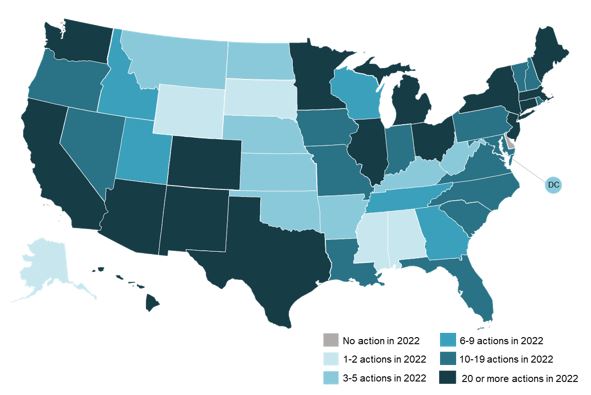The 50 States of Grid Modernization: States Focus on Resilience, Grid Management, and Utility Business Models During 2022
Raleigh, NC – (February 1, 2023) The N.C. Clean Energy Technology Center (NCCETC) released its 2022 annual review and Q4 2022 update edition of The 50 States of Grid Modernization. The quarterly series provides insights on state regulatory and legislative discussions and actions on grid modernization, utility business model and rate reforms, energy storage, microgrids, and demand response.
The report finds that 49 states and the District of Columbia took actions related to grid modernization during 2022 (see figure below), with the greatest number of actions relating to energy storage deployment, utility business model reforms, smart grid deployment, advanced metering infrastructure (AMI) deployment, distribution system planning, and time-varying rates.
2022 State and Utility Action on Grid Modernization

The report highlights ten of the top grid modernization trends of 2022:
- Focusing on resilience in grid modernization activities;
- Undertaking actions to enhance grid management and flexibility;
- Utilities proposing new performance incentive mechanisms;
- States considering wholesale market participation;
- Establishing formal distribution system planning processes;
- Utilities pursuing resiliency as a service programs;
- Utilities designing new battery storage demand response programs;
- States allowing cost sharing for grid upgrades needed for interconnection;
- Incorporating critical peak pricing into rate structures; and
- Examining battery storage decommissioning and recycling.
“Regulators and lawmakers across the country showed major interest in providing incentives for energy storage programs this year,” noted Emily Apadula, Policy Analyst at NCCETC. “Following a trend set in 2021, energy storage was again the most commonly targeted technology for incentives. This trend is expected to continue as concerns over grid reliability and resiliency become more prevalent.”
A total of 778 grid modernization actions were taken during 2022. The report notes that ten of the most active states in 2022 for grid modernization were:
- California, where regulators opened a rulemaking to advance demand flexibility through rates, continued work to develop a microgrid program, and considered a variety of proposed utility investments;
- Connecticut, where regulators approved a non-wires alternative program design, a reliability and resilience framework, and an innovative energy solutions program;
- Massachusetts, where state legislators enacted a bill requiring utilities to develop electric sector modernization plans and regulators approved significant grid modernization plans for the state’s three major utilities;
- Hawaii, where regulators approved additional performance incentive mechanisms, an advanced rate design framework, and a smart dispatch program;
- Maine, where lawmakers enacted legislation requiring utilities to file grid plans and regulators approved energy storage rates for Central Maine Power and Versant Power;
- Illinois, where regulators approved new performance metrics for Ameren and Commonwealth Edison and took steps to develop an integrated grid planning process;
- New Mexico, where the Energy, Minerals, and Natural Resources Dept. released a grid modernization roadmap and utilities filed plans for grid modernization investments;
- Colorado, where regulators proposed rules for organized wholesale markets and state legislators established new incentives for energy storage and microgrids;
- Michigan, where regulators formed a new workgroup on grid integration, considered energy storage participation in wholesale markets, and reviewed utility distribution plans; and
- Minnesota, where the Commission approved new load flexibility pilots for Xcel Energy and accepted utilities’ integrated distribution plans.
“States spent significant time exploring utility business model reforms during 2022, ranging from decoupling and performance-based regulation to wholesale market participation and retail competition,” observed Autumn Proudlove, lead author of the report and Associate Director of Policy & Markets at NCCETC. “Performance-based regulation was the most commonly considered reform, with several states moving forward with new performance incentive mechanisms.”
In Q4 2022, 47 states and D.C. took some type of action on distributed solar policy or rate design. A total of 422 actions were tracked in Q4.
View and Purchase the 50 States of Grid Modernization 2022 Q4 Update FULL Report
View other 50 States Reports – Solar, Grid Modernization and Electric Vehicles
ABOUT THE N.C. CLEAN ENERGY TECHNOLOGY CENTER
The N.C. Clean Energy Technology Center, as part of the College of Engineering at North Carolina State University, advances a sustainable energy economy by educating, demonstrating and providing support for clean energy technologies, practices and policies. It serves as a resource for innovative, sustainable energy technologies through technology demonstration, technical assistance, outreach and training. For more information about the Center, visit: http://www.nccleantech.
Media Contact, Shannon Helm, NCCETC, shannon_helm@ncsu.edu